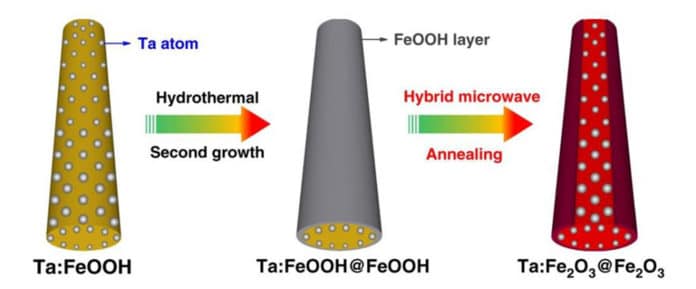The major factors driving the global green hydrogen market’s growth are the growing demand for renewable energy resources. However, a technology to produce so-called “green hydrogen” needs to be developed further for practical applications, employing water splitting using a renewable energy source.
Solar hydrogen is such an ideal innovation of creating hydrogen fuel from using sunlight, however, notwithstanding escalated research worldwide in the last decades, the advancement has been moderate.
Scientists from UNIST, in collaboration with scientists at Dalian Institute of Chemical Physics (DICP), China, have recently discovered a way to bring solar hydrogen production a step closer to reality.
Electrolysis of water into hydrogen and oxygen can be acknowledged yet requires a lot of electricity that is generally made by burning fossil fuels. Photoelectrochemical (PEC) water splitting gives an ecologically benign and more economical course to hydrogen production. Hematite is considered an ideal candidate photoanode material for large-scale use of PEC water parting due to its natural abundance, chemical robustness, and a perfect bandgap of 2.1 eV that permits a high solar to-hydrogen conversion effectiveness of 16.8 % (over 10% is a prerequisite for commercialization).
Realizing the high performance of hematite corresponding to its promising potential remains a significant challenge because of various limiting factors in its optoelectronic properties. Owing to these limitations, hematite photoanodes’ reported performance remains less than half of their potential performance.
Scientists successfully designed and constructed a novel nanostructured hematite-based photoanode, a core-shell formation of gradient tantalum-doped hematite homojunction nanorods combination of second hydrothermal growth and hybrid microwave annealing (HMA). The gradient Ta-doped homojunction nanorods result in high conductivity inside (heavy Ta5+ doping) while the surface states outside were passivated by removing surface defects caused by heavy Ta5+ doping.
More crucially, this constructs an additional electric field to suppress charge recombination, leading to a significant enhancement of photocurrent and a considerable decrease of turn-on voltage. Most of the known modification strategies enhance either photocurrent generation or reduce the current turn-on voltage.
The uniqueness of our newly-developed strategy is to improve the two figures of merit simultaneously. This work nicely demonstrates how the multiple strategies of high doping, homojunction, and cocatalyst loading enhance photoanode performance. As a result, the finally optimized photoanode improves photocurrent density by 66.8 % and shifts its turn-on voltage by ~270 mV relative to the unmodified photoanode.
This research’s findings have been published in the prestigious journal Nature Communications on September 15, 2020. This work has been supported by the Climate Change Response project and the Mid-career Researcher Program, funded by the Ministry of Science and ICT (MSIT).
Journal Reference:
- Zhang, H., Li, D., Byun, W.J. et al. Gradient tantalum-doped hematite homojunction photoanode improves both photocurrents and turn-on voltage for solar water splitting. Nat Commun 11, 4622 (2020). DOI: 10.1038/s41467-020-18484-8
